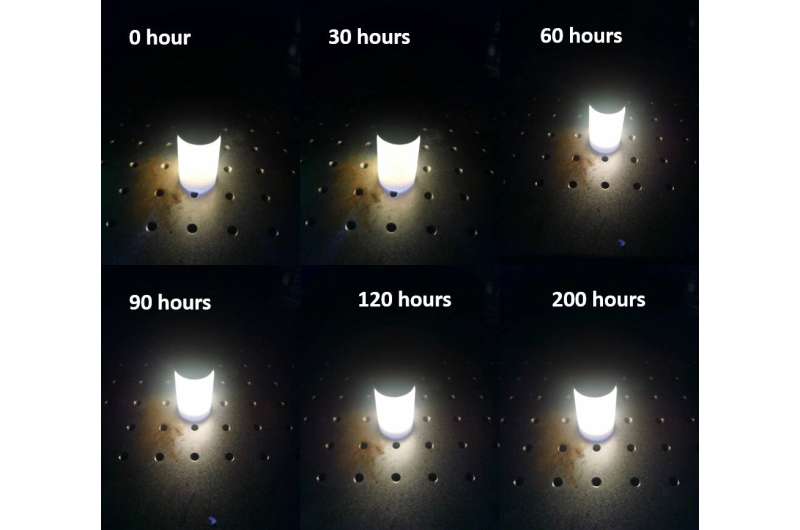This article has been reviewed according to Science X's editorial process and policies. Editors have highlighted the following attributes while ensuring the content's credibility:
fact-checked
proofread
Codoping double perovskites for single-component white-light-emitting diodes

A new paper published in Energy Material Advances explores Eu3+-Bi3+ codoping double perovskites for single-component white-light-emitting diodes.
"With lead-halide perovskites reaching a mature research stage approaching product marketing, concerns remain about the materials' stability and the toxicity of lead-based salts," said paper author Hongwei Song, professor at College of Electronic Science and Engineering, Jilin University.
Double perovskites with Cs2AgInCl6 composition, often doped with various elements, have been in the spotlight owing to their intriguing optical properties, namely, self-trapped exciton (STEs) emission and dopant-induced photoluminescence. This interest has sparked different synthesis approaches towards both crystals and nanocrystals, and the exploration of many alloy compositions with mono- and trivalent cations other than Ag+ and In3+.
Song explained that, in the development of lead-free perovskite materials, people's first thought is to replace Pb element with a non-toxic element. In order to replace Pb in halide perovskite, researchers chose several low-toxic cations in the same period closest to it, such as Sn, Ge, Bi, Sb, In, etc., because they have a similar inactive shell s orbital.
This is the key to the unique photoelectric properties of perovskite materials. Lead-based perovskite materials have attracted great attentions in solid-state lighting area due to their high efficiency, high color rendering and tunable luminescence performance. This is both an opportunity and a challenge for the overall development of the photoelectric industry.
"Since the pioneering work on Cs2AgInCl6 in 2017 reported by Giustino et al. and Zhou et al. nearly simultaneously, many efforts have been devoted to its synthesis, modification of its composition, study of its electronic structure, optoelectronic properties, and applications. Recently, a record of white light emission with 86 % PLQY was achieved by Luo et al. via simultaneous alloying of Ag+ with Na+ and Bi3+ doping, marking an important milestone in the development of Cs2AgInCl6 related materials," Song said.
"Despite several advantages, major issues with these lead halide perovskites remain their poor stability and toxicity. In order to solve such problems, various attempts have been made to reduce the toxicity of perovskites while still maintaining their efficient optical properties."
The existence of Bi3+ ions decrease the excitation (absorption) energy, provides a new absorption channel and increases the energy transfer rate to Eu3+ ions. Through adjusting the Bi3+ and Eu3+ concentrations, a maximum photoluminescence efficiency (PLQY) of 80.1% is obtained in 6% Eu3+ and 0.5% Bi3+ co-doped Cs2AgInCl6 DPs.
"The energy transfer efficiency can be fitted with the decay rates under different Bi3+ doping concentrations. It can be seen that the energy transfer rate improves as a whole with the increase of the doping concentration of Bi3+, and the optimum energy transfer rate corresponding to the Bi3+ concentration is 0.5%. Next, we conducted PLQY test on the materials. For the undoped Cs2AgInCl6 DPs, PLQY is only 0.5%, which dramatically increases to 20.1% after the addition of Bi3+. After [being] co-doped with Eu3+ and Bi3+ ions, PLQY continues to increase, and reaches the maximum of 80.1% when the Eu concentration reaches 6%," Song said.
"Here, we propose a possible mechanism to describe Eu3+ emission in Bi/Eu3+: Cs2AgInCl6. Cs2AgInCl6 DP is a direct bandgap semiconductor. Bi3+ doping provides a new absorption channel for the material, which may be caused by the contribution of the Bi3+ orbital in the band edge, breaking the STE-state compatibility ban transition, generating a new light absorption channel at a lower energy, and promoting the PLQY emitted by STE. For the Eu3+emission, we think there are two pathways. First, the energy transfer from STE to Eu3+ ions is possible as we have observed the Eu3+ emission in the Eu3+ doped Cs2AgInCl6 DPs. Second, the Eu3+ emission may mainly come from the energy transfer from Bi3+ ions to Eu3+ ions. The Bi3+ ions absorb the excitation light and transfer the energy from 1P1, 3P2, 3P1, 3P0 levels of Bi3+ ions to 5D3, 5D2, 5D1 and 5D0 levels of Eu3+ ions. The characteristic emission of Eu3+ ions is then formed through 5D0→7Fj(j=0,1,2,3) transitions."
"Finally, we prepared the white light emitting diodes based on Bi3+ and Eu3+ codoped Cs2AgInCl6 DPs were fabricated with the optimum color rendering index of 89, the optimal luminous efficiency of 88.1 lm/W and a half-lifetime of 1493 h. This strategy of imparting optical functions to metal halide DPs may lead to future applications, such as optical fiber communications, daily lighting, military industry, displays, and other fields," Song said.
More information: Tianyuan Wang et al, Eu3+-Bi3+ Codoping Double Perovskites for Single-Component White-Light-Emitting Diodes, Energy Material Advances (2023). DOI: 10.34133/energymatadv.0024
Provided by Beijing Institute of Technology Press Co., Ltd





















